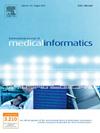Digital twins in cardiovascular disease: a scoping review
IF 4.1
2区 医学
Q2 COMPUTER SCIENCE, INFORMATION SYSTEMS
International Journal of Medical Informatics
Pub Date : 2025-10-08
DOI:10.1016/j.ijmedinf.2025.106138
引用次数: 0
Abstract
Background
Digital twin technology in healthcare is an emerging approach that creates virtual representations of patients and disease-specific conditions, with the potential to clarify treatment objectives and enable more personalized, precision-based care, to help to clarify treatment objectives and to facilitate personalised and precision treatment management.
Objective
This scoping review was conducted to analyse the application of digital twin technology in cardiovascular disease, focusing on implementation steps, clinical applications, and challenges to guide future research.
Methods
A systematic search was conducted in eight databases (PubMed, EBSCO, Web of Science, WILEY, China WanFang Database, China National Knowledge Infrastructure, China Weipu Database, and SinoMed) for studies published, with a time frame of database construction to May 2025. Data were summarised and analysed based on predefined criteria.
Results
A total of 31 cardiovascular studies were included. Their implementation was categorised into five stages: data acquisition, model construction and personalisation, model calibration and validation, simulation analysis, and result application for decision support or medical education. Clinical applications involved personalised health management (13 %), precise individual treatment effects (42 %), individual risk prediction (26 %), clinical trial optimisation (23 %), and medical education (3 %). Key challenges included data limitations, model construction and validation complexities, and barriers to clinical application.
Conclusion
Digital twins demonstrate potential in cardiovascular care by advancing personalised health management and precision medicine. However, their widespread adoption and practical implementation are still in their early stages. Broader implementation necessitates improved data sharing, algorithm optimisation, enhanced model generalizability, and ethical safeguards.
心血管疾病中的数字双胞胎:范围综述
医疗保健领域的数字孪生技术是一种新兴方法,它可以创建患者和特定疾病的虚拟表示,有可能明确治疗目标,实现更个性化、更精确的护理,帮助明确治疗目标,促进个性化和精确的治疗管理。目的分析数字孪生技术在心血管疾病中的应用,重点分析实施步骤、临床应用和面临的挑战,以指导未来的研究。方法系统检索PubMed、EBSCO、Web of Science、WILEY、中国万方数据库、中国国家知识基础设施、中国卫普数据库、中国医学信息数据库等8个数据库中已发表的研究,数据库建设时间为2025年5月。根据预先确定的标准对数据进行总结和分析。结果共纳入31项心血管研究。它们的实施分为五个阶段:数据采集、模型构建和个性化、模型校准和验证、仿真分析以及结果应用于决策支持或医学教育。临床应用包括个性化健康管理(13%)、精确的个体治疗效果(42%)、个体风险预测(26%)、临床试验优化(23%)和医学教育(3%)。主要挑战包括数据限制、模型构建和验证的复杂性以及临床应用的障碍。结论数字双胞胎通过推进个体化健康管理和精准医疗,在心血管保健方面显示出潜力。然而,它们的广泛采用和实际实施仍处于早期阶段。更广泛的实施需要改进数据共享、算法优化、增强模型泛化性和道德保障。
本文章由计算机程序翻译,如有差异,请以英文原文为准。
求助全文
约1分钟内获得全文
求助全文
来源期刊

International Journal of Medical Informatics
医学-计算机:信息系统
CiteScore
8.90
自引率
4.10%
发文量
217
审稿时长
42 days
期刊介绍:
International Journal of Medical Informatics provides an international medium for dissemination of original results and interpretative reviews concerning the field of medical informatics. The Journal emphasizes the evaluation of systems in healthcare settings.
The scope of journal covers:
Information systems, including national or international registration systems, hospital information systems, departmental and/or physician''s office systems, document handling systems, electronic medical record systems, standardization, systems integration etc.;
Computer-aided medical decision support systems using heuristic, algorithmic and/or statistical methods as exemplified in decision theory, protocol development, artificial intelligence, etc.
Educational computer based programs pertaining to medical informatics or medicine in general;
Organizational, economic, social, clinical impact, ethical and cost-benefit aspects of IT applications in health care.
 求助内容:
求助内容: 应助结果提醒方式:
应助结果提醒方式:


